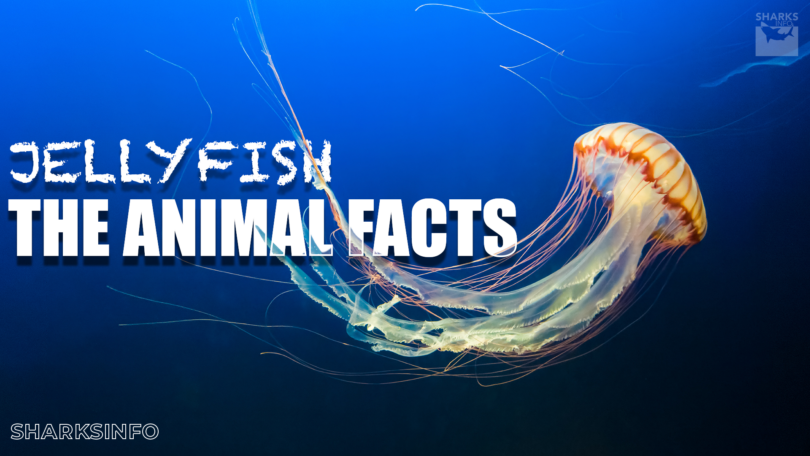Fish live in water and have gills for breathing, but they lack limbs, toes, and fingers. Have you ever wondered whether a Jellyfish is considered a fish? The answer is no, Jellyfish are fascinating creatures with no backbone. They are freely living marine animals, are also known by the common name Aurelia, and belong to the phylum Cnidaria.
The Jellyfish are Gelatinous Zooplankton, animals that do not have any hard parts in their bodies and can be easily damaged or destroyed. It is more accurate to refer to the Jellyfish as simply jellies.

Jellyfish have been cruising and floating in water for millions of years, even before the existence of dinosaurs. There are almost 2000 species of Jellyfish present around the world and they are similar to their prehistoric ancestors. Some common Jellyfish include moon Jellyfish, box Jellyfish, Comb Jellyfish, etc.
In this guide we will discuss:
- Fast Jellyfish Facts
- What are Jellyfish? Where Do They Live?
- What Do Jellyfish Eat?
- Life Cycle of Jellyfish
- Anatomy of Jellyfish
- Jellyfish: The Animal Facts
Fast Jellyfish Facts
Common name: Golden Jellyfish
Scientific name: Mastigias papua etpisoni
Type: Invertebrate
Phylum: Cnidaria
Subphylum: Medusozoa
Habitat: Oceans
Weight: Up to 2 KG with body size of 2 cm to 2m
Food: Eat plankton, fish, shrimp, crab, and other tiny plants

What are Jellyfish? Where Do They Live?
Jellyfish are a free-swimming diverse group of marine animals that vary in range, appearance, and size from a few millimeters to two meters in diameter. They are transparent animals with umbrella-shaped bells and tentacles. They used tentacles to capture and sting their prey. The Jellyfish uses stingy cells in tentacles to stun and paralyze the prey before eating them.
Jellyfish are marine animals, but few can stay in freshwater. They are found worldwide from cold-warm water to deep water and along coastlines. They travel in groups known as Bloom, Smack, or Swarm, there are approximately 100,000 Jellyfish in one Bloom. They have limited control over their movements using muscles to contract and relax their bells in opposite directions to move to the shortest distance.

What Do Jellyfish Eat?
The Jellyfish are carnivorous animals, which means they eat meat and enjoy feeding other sea creatures. The diet of Jellyfish mostly consists of Shrimp, Fish, tiny plants, Crabs, and other marine-based animals. The largest Jellyfish can even eat small Jellyfish. Some Jellyfish eat tiny plants. They are opportunistic feeders and eat whatever prey is available in the environment. They are also known to compete with other marine animals for food.

Despite the fact of the simpler anatomy of Jellyfish, they have a digestive system. They can digest their food quickly. The digestive system consists of a large oral cavity that produces the necessary things to break down food.
Life Cycle of Jellyfish
Some Jellyfish are male, and some are female, but few are hermaphrodites, they are both male and female. Many people do not know the ways that the Jellyfish reproduce, they follow a mix of sexual reproduction and asexual reproduction. A few species of Jellyfish release eggs or sperm from their mouth and they fertilize outside the body, others carry their eggs in their mouth until the baby’s form.

Jellyfish have three basic life stages: Polyps, ephyra, and Medusa. When Jellyfish are in the first stage it is known as Polyps, they attach to the rocks at the bottom of the water and grow in buds like plants.
When the Polyps bud off, they transform into a little Jellyfish known as ephyra and after a few weeks, ephyra grows into Medusa (adult Jellyfish).
The damaged tissues of Jellyfish can regenerate themselves into fully functional Jellyfish.
Anatomy of Jellyfish
The Jellyfish are made up of 95% water, and the other 5% are proteins, muscle, and nerve cells. Below we have listed the basic anatomical characteristics of Jellyfish:
1: Jellyfish Lack Respiratory System
They do not have a respiratory system. The skin of the Jellyfish is so thin that they get oxygen from the process of diffusion.
2: Jellyfish Have Mouth
They have one orifice that works of the mouth as well as the anus. The mouth is in the center of the body.
3: Jellyfish have No Brain
They do not have brains but have nerves, they consist of 10,000 neurons that detect touch, temperature, and salinity.
4: Not all Jellyfish have Tentacle
All Jellyfish have tentacles to capture and sting their prey. The largest jellyfish lion’s mane jellyfish can extend their tentacles longer than blue whales (the largest mammal on earth), 120 ft long. The Jellyfish use tentacles in twisted and spiral patterns to trap prey and others drag tentacles behind them and crawl into the ocean. Some Jellyfish protect the smaller jellyfish by hiding them in their tentacles. The Deepstaria is the only jellyfish that lacks a tentacle, it has a thin sheet body.
5: Jellyfish Lack Eyes
Although the jellyfish do not have eyes, Box Jellyfish are the only Jellyfish with 24 eyes around their bells and have 360-degree vision.

6: Jellyfish Has Hydrostatic Skeletons
The Jellyfish have hydrostatic skeletons, they have fluid and circular muscles instead of bones and have no blood.
7: Some Jellyfish Have Teeth
Generally, Jellyfish lack teeth but the beroid comb Jellyfish has hundreds of rows of teeth that are made up of hairs and they use these teeth to pull the prey to the stomach.
The Other Animal Facts of Jellyfish
Following are the animal facts about Jellyfish:
1: Jellyfish Lack Bilateral Symmetry
Jellyfish are different from other animals, they do not have a right or left side, and they have no front or back. They have Radial Symmetry as they are symmetrical around a central axis. They must be halved in numerous parts to produce identical parts.
2: Jellyfish Are Edible
Jellyfish are an excellent source of nutrition, so turtles and many other oceanic animals love to eat them. Jellyfish are also used for preparing medicine in China. The 25 types of Jellyfish are edible, have a salty taste, and are used in Salads and pickles.
3: Jellyfish, the Fastest Animal
The Jellyfish is the fastest marine animal. It moves six meters in one minute.
4: Jellyfish Have Been to Space
The Jellyfish were Launched into space for experiments to test how they react with no gravity. Although they reproduced in space, the space-reproduced Jellyfish were not functioning properly when they returned to Earth.
5: Jellyfish Save Ocean From Microplastic
A few species of Jellyfish including moon jelly and nomad jellies excrete mucus to absorb tiny particles of plastic in the ocean. Glojelly is working on a filter system that reverses the plastic pollution problems affecting our oceans.
6: Jellyfish are Bioluminescent
Some Jellyfish are bioluminescent, which means they produce their own light and internal glow. They procured the light and used it to attract prey and defend against predators. They also send glowing particles in the water to confuse the prey.

7: Jellyfish are Colorful
They are transparent creatures or have a vibrant array of one or more than one color. Few jellyfish are transparent, but others exist in color including pink, yellow, blue, and luminescent.
8: Jellyfish are Immortal
The short life span of a Jellyfish is from a few hours to less than a year. The Jellyfish known as Turritopsis dohrnii is immortal. it transforms back into a colony of polyps.
9: Jellyfish are Poisonous
Not all Jellyfish are poisonous, but some species of Jellyfish can deliver a painful sting that is harmful for humans and other animals. The sensitivity of the sting depends on the species, size, and individual who has been stung.
The Jellyfish has stinging cells in their tentacles known as Nematocysts for stinging and paralyzing the prey. The sting from jellyfish causes a massive amount of pain and even death. Chironex fleckeri is a life-threatening Jellyfish to humans, this creature can cause cardiac arrest, and death within minutes. Jellyfish stings humans at the rate of 150 million per year.
The box Jellyfish is the most venomous marine animal with a cube-shaped body and poisoned dart tentacles.
10: Jellyfish Can Feel
The Jellyfish can feel and respond as well. They respond to the environment by running towards food and away from damage.
11: Jellyfish Are Adaptable
The Jellyfish adapt well to climatic changes. They can change their size in response to changes in food availability, growing larger and smaller depending on the prey distance.
Another way to adapt to the environment is by developing specialized features that help them to survive in different types of conditions. They are living in oceans despite overfishing, ocean acidification, and many other human activities.
Bottom Line
The Jellyfish are frightening but fascinating marine creatures. They are carnivorous animals with 95% of water in their bodies. The unique feature is they have poison-filled tentacles to attack their prey. They capture the marine creatures using these tentacles and feed on them. The Jellyfish can clone themselves using sexual and asexual reproduction. They do not have a respiratory system or brain, but they have nerves to sense the environmental changes. This guide has provided a detailed discussion about Jellyfish, including what they are, what they eat, their lifecycle, and facts.







